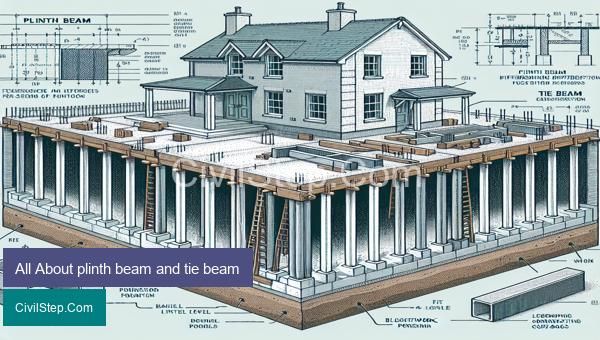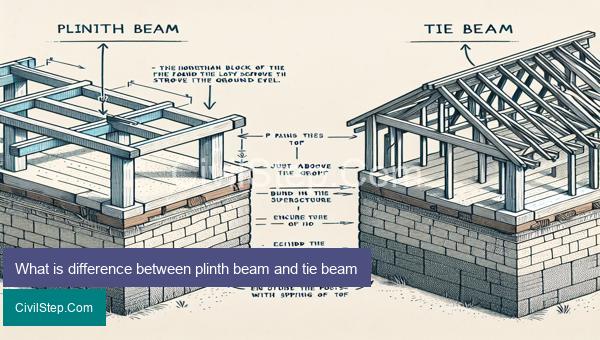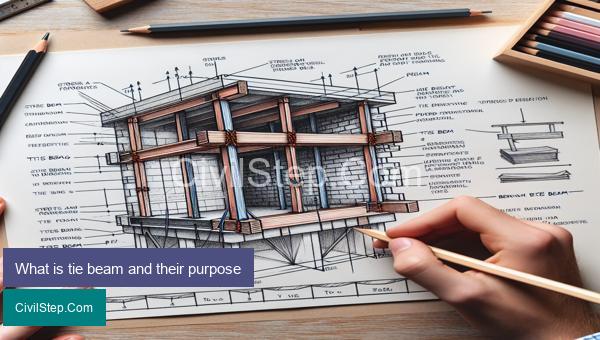
Plinth beam and tie beam are two essential components in the construction of a building. These horizontal structural elements play a crucial role in providing stability and strength to the overall structure, especially in areas with high seismic activity. Despite their importance, many people are not familiar with the purpose and functions of plinth beam and tie beam. In this article, we will delve into the details of these two beams, discussing their construction, types, and significance in a building’s structural integrity. So whether you are a builder, architect, or simply curious about the world of construction, read on to discover all you need to know about plinth beam and tie beam.
What is difference between plinth beam and tie beam

Plinth beam and tie beam are two important elements in a building structure. Both serve different purposes and play a crucial role in providing stability and strength to the building. Here are the main differences between plinth beam and tie beam.
1. Function: The function of a plinth beam is to distribute the load of the masonry walls evenly to the foundation. It acts as a base for the construction of the walls and prevents the settlement of the building. On the other hand, tie beam is used to provide lateral support to the columns and prevent the building from swaying. It also helps in distributing the load of the roof to the columns evenly.
2. Location: Plinth beam is located at the ground level and is the first horizontal beam that is constructed above the foundation. It is usually made of reinforced concrete and runs along the outer periphery of the building. Whereas, tie beam is placed at a higher level, usually above the doors and windows and connecting all the columns in a horizontal plane.
3. Load-bearing Capacity: Plinth beams are designed to carry the load of the masonry walls and the weight of the building. They are typically wider and stronger than tie beams. Tie beams, on the other hand, are designed to resist the lateral forces such as wind and earthquake loads. Hence, they are not designed to bear heavy vertical loads.
4. Construction: Plinth beams are constructed at the initial stage of the building construction, along with the foundation. The height and width of the plinth beam are determined based on the load they are expected to carry. Whereas, tie beams are constructed once the columns are in place and before the construction of the roof. They are generally thinner and shorter compared to plinth beams.
5. Shape and Size: Plinth beams are usually rectangular in shape with a width that is equal to the thickness of the wall. In case of load-bearing walls, the width of the plinth beam is increased to carry the extra load. Tie beams are also rectangular in shape, but their width and depth are small compared to plinth beams. They are designed based on the length of the span and the load they are expected to carry.
In conclusion, while both plinth beam and tie beam are important for the stability of a building, their functions, location, load-bearing capacity, construction process, and size differ from each other. It is essential to ensure their proper design and construction to avoid any structural failures and maintain the overall strength and stability of the building.
Function of plinth beam providing in structure

A plinth beam is a reinforced concrete beam that is provided at the ground level of a building structure. It is usually constructed at the bottom of the wall, between the foundation level and the ground floor level. The main function of a plinth beam is to distribute the load of the superstructure (i.e. the walls and floors) evenly onto the foundation.
The following are the main functions of a plinth beam in a building structure:
1. Load Distribution: The plinth beam acts as a load-bearing element between the foundation and the walls of the building. The load from the walls and floors is transferred onto the plinth beam, which then distributes it evenly onto the foundation. This helps to prevent any differential settlement and ensures the stability of the structure.
2. Structural Stability: A plinth beam helps to strengthen the building structure by providing stability against lateral forces such as earthquakes, high winds or any other external forces. The beam functions as a continuous support at the base of the building, providing resistance to any horizontal movement or deformation.
3. Prevents Soil Erosion: The plinth beam helps to protect the foundation from soil erosion. It is designed to prevent water from seeping into the foundation and causing damage. The beam also acts as a barrier for termites and other pests that may attack the structure from the ground level.
4. Provides a Level Base: The plinth beam is constructed at a level higher than the ground level, which helps to provide a level base for the walls and floors. This ensures that the walls and floors are not in direct contact with the soil, which in turn prevents dampness and seepage into the structure.
5. Supports the Superstructure: A plinth beam also provides support to the walls of the structure. The walls are connected to the plinth beam through vertical reinforcements, which help to distribute the load of the superstructure onto the beam.
6. Fulfils Building Codes: Plinth beams are a mandatory requirement in most building codes and are designed and constructed in accordance with the specifications and guidelines set by the relevant authorities. Adhering to these codes ensures the safety and structural integrity of the building.
In conclusion, the function of a plinth beam in a building structure is crucial for providing stability, load distribution, and protection against external forces and soil erosion. It is an essential component of a building that ensures the durability and longevity of the structure.
What is tie beam and their purpose

Tie beam, also known as collar beam or cross beam, is a horizontal structural element that connects and supports two or more vertical members such as columns or roof trusses. It is typically made of reinforced concrete, timber, or steel and is installed at a specific level between the two supporting members.
The main purpose of a tie beam is to provide lateral stability and prevent the vertical members from spreading apart. When a structure is subjected to horizontal forces such as wind or earthquake, the columns tend to move away from each other, causing the building to collapse. However, tie beams resist these forces and hold the columns together, making the structure more stable.
Apart from providing lateral stability, tie beams also help in transferring the load of the roof and upper floors to the supporting columns. This helps in distributing the weight evenly and reduces the stress on the columns, preventing them from buckling under heavy loads.
Another important function of tie beams is to prevent the vertical members from bending due to external loads. When a building is subjected to a heavy load, the columns tend to bend outward, resulting in cracks or failure of the structure. The installation of tie beams at regular intervals helps in restraining the outward movement of the columns, thereby preventing damage to the building.
Tie beams also enhance the structural integrity of a building. In simple roof trusses, where there are no walls to support the roof load, the beams act as a compression member and spread the load to the supporting columns. This makes the roof stronger and prevents it from sagging.
In addition to providing structural stability, tie beams also add aesthetic value to a building. They are often used as decorative elements and can be designed in various shapes and sizes to enhance the visual appeal of a structure.
In conclusion, tie beams play a crucial role in maintaining the stability and integrity of a building. They serve as a vital link between the columns and transfer the load of the structure to the ground, preventing any potential damage or collapse. Therefore, they are an essential component of any structural design and must be carefully planned and executed to ensure the safety and stability of a building.
What is difference between plinth beam and tie beam

Plinth beam and tie beam are two important elements in a building structure. Both serve different purposes and play a crucial role in providing stability and strength to the building. Here are the main differences between plinth beam and tie beam.
1. Function: The function of a plinth beam is to distribute the load of the masonry walls evenly to the foundation. It acts as a base for the construction of the walls and prevents the settlement of the building. On the other hand, tie beam is used to provide lateral support to the columns and prevent the building from swaying. It also helps in distributing the load of the roof to the columns evenly.
2. Location: Plinth beam is located at the ground level and is the first horizontal beam that is constructed above the foundation. It is usually made of reinforced concrete and runs along the outer periphery of the building. Whereas, tie beam is placed at a higher level, usually above the doors and windows and connecting all the columns in a horizontal plane.
3. Load-bearing Capacity: Plinth beams are designed to carry the load of the masonry walls and the weight of the building. They are typically wider and stronger than tie beams. Tie beams, on the other hand, are designed to resist the lateral forces such as wind and earthquake loads. Hence, they are not designed to bear heavy vertical loads.
4. Construction: Plinth beams are constructed at the initial stage of the building construction, along with the foundation. The height and width of the plinth beam are determined based on the load they are expected to carry. Whereas, tie beams are constructed once the columns are in place and before the construction of the roof. They are generally thinner and shorter compared to plinth beams.
5. Shape and Size: Plinth beams are usually rectangular in shape with a width that is equal to the thickness of the wall. In case of load-bearing walls, the width of the plinth beam is increased to carry the extra load. Tie beams are also rectangular in shape, but their width and depth are small compared to plinth beams. They are designed based on the length of the span and the load they are expected to carry.
In conclusion, while both plinth beam and tie beam are important for the stability of a building, their functions, location, load-bearing capacity, construction process, and size differ from each other. It is essential to ensure their proper design and construction to avoid any structural failures and maintain the overall strength and stability of the building.
Conclusion
In conclusion, plinth beam and tie beam are essential structural elements that play crucial roles in providing stability and strength to a building. They act as a connecting link between the foundation and the superstructure, distributing the load evenly and preventing the building from collapsing. Proper design and construction of these beams are crucial for the longevity and safety of a building. It is important to adhere to the guidelines and standards set by structural engineers while constructing these beams. Regular maintenance and timely repairs of plinth beams and tie beams are necessary to ensure the structural integrity of a building. With proper planning and execution, plinth beam and tie beam can effectively provide a stable and durable foundation for any type of structure.
